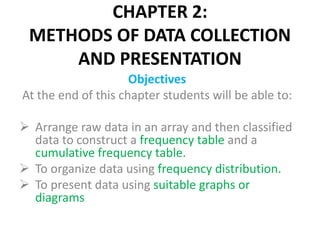Chapter 2 covers methods of data collection and presentation, teaching students to arrange and classify raw data into frequency tables and present it using graphs. It distinguishes between primary and secondary data, explains classification and frequency distribution, and details methods for presenting data both tabularly and graphically. Key presentation methods include histograms, pie charts, and bar charts, each with specific construction techniques and examples provided.



![2.2. Methods of Data Presentation
• The presentation of data is broadly classified in to the
following two categories:
Tabular presentation
Diagrammatic and Graphic presentation
The process of arranging data in to classes or
categories according to similarities technically is called
classification.
It eliminates inconsistency and also brings out the
points of similarity and/or dissimilarity of collected
items/data.
Classification is necessary because it would not be
possible to draw inferences and conclusions if we have
a large set of collected [raw] data.](https://image.slidesharecdn.com/ch2pptforbesicstatistics-240511231155-2e116839/85/Basic-statistics-for-marketing-management-4-320.jpg)





































